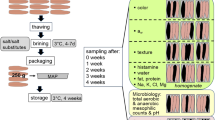Abstract
Salted fish is a traditional Chinese aquatic product, because of its rich nutrition and the salty, sweet, unique taste and flavor, it is loved by consumers. At present, empirical traditional processing methods are adopted in enterprises that processing salted aquatic products, which have many disadvantages not only in the production scale, but also its efficiency. In order to innovate the traditional salted fish processing technology, as well as to meet the demand of modern consumers for salted fish with lower salt, richer nutrition, higher safety, better quality and flavor, this paper reviews researches on the isolation of dominant microorganisms in traditional salted fish and the application of lactic acid bacteria and other microorganisms in the salted fish processing, further, puts forward the tendency of applying modern microbial technologies to the processing of salted fish products.
Access this chapter
Tax calculation will be finalised at checkout
Purchases are for personal use only
Similar content being viewed by others
References
Tian GJ, Shang YY, Huang ZY et al (2011) The dominant lactic acid bacteria fish separation, purification and characterization. Food Ferment Ind (Chin) 37(6):78–81
Wood BJB (1997) Microbiology of fermented foods, vol 1, 2. Springer, New York
Paludan-Müller C, Madsen M, Sophanodora P et al (2002) Fermentation and microflora of plaa-som, a Thai fermented fish product prepared with different salt concentrations. Int J Food Microbiol 73(1):61–70
Nimnoi P, Lumyong S (2011) Improving solid-state fermentation of monascus purpureus on agricultural products for pigment production. Food Bioprocess Tech 4(8):1384–1390
Liu FJ, Wu YY, Li LH et al (2012) Nitrite degradation characteristics of lactic acid bacterium from salted fish. Guangdong Agr Sci (Chin) 39(1):94–97
Wu YY, Liu FJ, Li LH et al (2012) Isolation and identification of nitrite-degrading lactic acid bacteria from salted fish. Adv Mater Res 393–395:828–834
Daeschel MA, Andersson RE, Fleming HP (1987) Microbial ecology of fermenting plant materials. FEMS Microbiol Lett 46(3):357–367
Xie J, Xiong SB, Zeng LB et al (2009) Lactic acid bacteria in cured fish and its growth properties. Food Ferment Ind (Chin) 35(6):32–36
Tanasupawat S, Shida O, Okada S et al (2000) Lactobacillus acidophilus sp. nov. and Weissella thailandensis sp. nov. isolated from fermented fish in Thailand. Int J Syst Evol Microbiol 50(4):1479–1485
Kanno T, Kuda T, An C et al (2012) Radical scavenging capacities of saba-narezushi, Japanese fermented chub mackerel, and its lactic acid Bacteria. Food Sci Technol 47(1):25–30
Hansen EB (2002) Commercial bacterial starter cultures for fermented foods of the future. Int J Food Microbiol 78(1–2):119–131
Anshu S, Arindam K, Sunita A et al (2011) Use of fermentation technology on vegetable residues for value added product development: A concept of zero waste utilization. Int J Food Ferment Technol 1(2):173–184
Riebroy S, Benjakul S, Visessanguan W (2008) Properties and acceptability of Som-fug, a Thai fermented fish mince, inoculated with lactic acid bacteria starters. LWT Food Sci and Technol 41(4):569–580
Ndaw A, Zinedine A, Faid M et al (2008) Effect of controlled lactic acid bacterial fermentation on the microbiological and chemical qualities of Moroccan sardines (Sardina pilchardus). Acta Microbiol Immunol Hung 55(3):295–310
Ly MH, Covarrubias-Cervantes M, Dury-Brun C et al (2008) Retention of aroma compounds by lactic acid bacteria in model food media. Food Hydrocolloid 22(2):211–217
Holzapfel WH, Geisen R, Schillinger U (1995) Biological preservation of foods with reference to protective cultures, bacteriocins and food-grade enzymes. Int J Food Microbiol 24(3):343–362
Ray B, Daeschel M (1992) Food biopreservatives of microbial origin. CRC Press, Boca Raton
Alvarado C, Garcia Almendarez BE, Martin SE, Regalado C (2006) Food-associated lactic acid bacteria with antimicrobial potential from traditional Mexican foods. Rev Latinoam Microbiol 48(3–4):260–268
Wu YY, You G, Li LH et al (2014) Comparison of flavor components between low-salt lactic acid fermented fish and traditional salted fish. J Fish China (Chin) 38(4):600–611
Corbiere Morot-Bizot S, Leroy S, Talon R (2006) Staphylococcal community of a small unit manufacturing traditional dry fermented sausages. Int J Food Microbiol 108(2):210–217. doi:10.1016/j.ijfoodmicro.2005.12.006
Zhou CY, Huang ZY, Tian GJ (2012) Application of lactobacilli in cured fish. Food Sci (Chin) 33(1):215–218
Zhou WJ, Wu YY, Li LH et al (2009) Utilization of compound lactobacillus in cured tilapia preparation. Food Sci (Chin) 30(23):242–245
Liu L, Wu ZF, Tu SF (2008) Study on effects of lactic acid bacteria on the quality of low-salt pickled fish. Beijing: China’s scientific and technical papers online. http://www.paper.edu.cn/releasepaper/content/200807-256
Oberman H, Libudzisz Z (1997) Fermented milks. In: Wood BJB (ed) Microbiology of fermented foods. Blackie Academic and Professional, London, pp 308–350
Uchida M, Ou J, Chen BW et al (2005) Effects of soy sauce koji and lactic acid bacteria on the fermentation of fish sauce from freshwater silver carp Hypophthalmichthys molitrix. Fish Sci 71(2):422–430
Tan RC, Ouyang JM, Lu XL et al (2007) Fermentation conditions of yuzha by inoculated Lactobacillus plantarum and Pediococcus pertosaceus. Food Sci (Chin) 28(12):268–272
Katikou P, Ambrosiadis I, Georgantelis D et al (2007) Effect of Lactobacillus cultures on microbiological, chemical and odour changes during storage of rainbow trout fillets. J Sci Food Agric 87(3):477–484
Acknowledgments
This research project is financially supported by The National Natural Science Foundation of China (31371800), the Basic Scientific Research Business Expenses Aid of Chinese Academy of Fishery Sciences (2013A1001, 2014C05XK01), and Special Promotion of Guangdong Marine Fishery Science and Technology (A201301C01).
Author information
Authors and Affiliations
Corresponding author
Editor information
Editors and Affiliations
Rights and permissions
Copyright information
© 2015 Springer-Verlag Berlin Heidelberg
About this paper
Cite this paper
Wu, Y.Y., You, G., Li, L.H. (2015). The Application Status of Microbes in Salted Fish Processing. In: Zhang, TC., Nakajima, M. (eds) Advances in Applied Biotechnology. Lecture Notes in Electrical Engineering, vol 332. Springer, Berlin, Heidelberg. https://doi.org/10.1007/978-3-662-45657-6_64
Download citation
DOI: https://doi.org/10.1007/978-3-662-45657-6_64
Published:
Publisher Name: Springer, Berlin, Heidelberg
Print ISBN: 978-3-662-45656-9
Online ISBN: 978-3-662-45657-6
eBook Packages: Chemistry and Materials ScienceChemistry and Material Science (R0)




